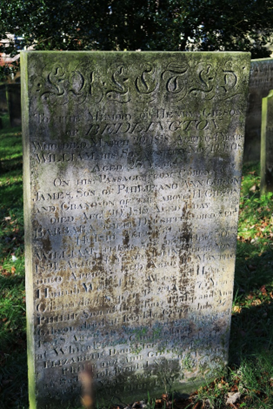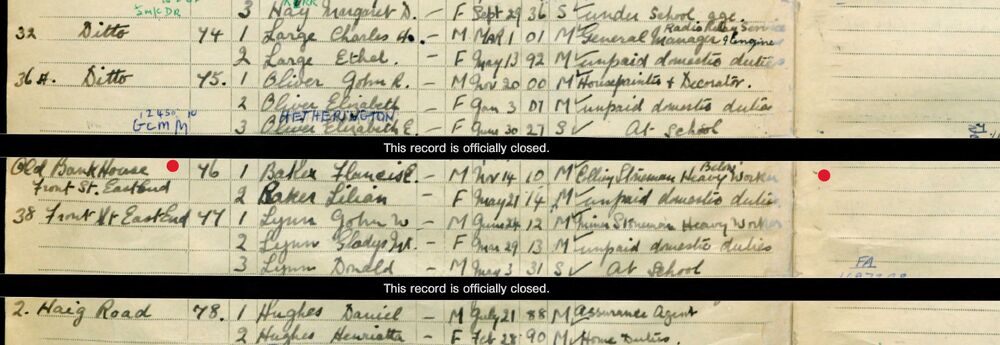Contributor Leaderboard
Popular Content
Showing content with the highest reputation since 22/04/24 in Posts
-
@stustep Yes, it certainly is but there is a connection between Dunn's the Drapers and the Gibson family. Mary Ellen Gibson, born 1852 to Henry Gibson (credited with being the founder of the chain & nail business) and his wife Mary, married draper Lewis Dunn in 1877 and left the family home (Bank House) to join her husband above the shop further up the street. She and Lewis had four children. Unfortunately, Lewis died aged about 40 years in 1885 leaving Mary a widow at the age of 33 with four children - the youngest only months old. She continued to run the drapery business until at least 1891 and possibly longer. In 1901 she and 3 of her children were once again living in Bank House together with her brother and their now frail and infirm father Henry, Be careful! It can get quite addictive!2 points
-
Hi everyone So I’ve been having a good old rummage through planning and t’internet the Gibson did own 34-38 front street for many years it would seem (still it got lots of history on that yet but I’m waiting for the last of the nailers article … sometime in the 70-80’s the building was taken over by City Vending and they applied for planning permission to convert the building into the commercial units offices and a new flat in about 1978… it’s unclear if this work was carried out but it remained in their hands till the early 2000’s I think during this time the whole building was called Conal House … at that point in around 2002 a builder called Mackay bought all 3 properties and made 2 homes to the front and 2 newer homes to the back 38 front street disappeared at this point from the address and the shop fronts were redeveloped and doors bricked up creating 34 and 36 front street.2 points
-
The Gibson's were an interesting family well worthy of a it of research. Here's the start of a few posts that may help you get acquainted with them and their business. August 28 1753 a wedding, which will eventually lead to a blue plaque being placed on the house currently known as 34 and 36 Front Street East, Bedlington, takes place at St Cuthbert’s Church in the town. The house is the former home of the Gibson family – the last of the Bedlington nailers. The groom is 23 year old Humphrey Gibson, and his 21 year old bride is a Bedlington girl, Ann Stephenson. In March the following year, 1754, the couple’s are once again in St Cuthbert’s Church, this time to celebrate the baptism of their firstborn – twins William and Henry Gibson. Very little else is known of Humphrey and Ann, though it’s possible to assume that Ann dies young as Humphrey remarries in 1766 when the twins are just 12 years old. His bride on this occasion is Isabel Moss. Of the twin William I can find no information but Henry is raised in Bedlington. He later meets his wife, Stannington-born Hannah Jameson and they also marry at St Cuthbert’s in November 1784 when both are 30 years old. Together the couple have five known children: William born 1785, Philip born 1788, Henry born 1790, Ann born 1792 and Hannah born 1794. November 19th 1808 their oldest son William, then aged 23 years, is lost on a passage from Corunna, Spain, where he is a mate on board the Providence, an army transport returning from the Peninsular War – part of the wider Napoleonic wars. Almost home, the ship and all hands are lost in a storm at Bolt Head near Salcombe, Devon and the master, Robert Denton, is the only survivor. (Source: McDonald, K., 1992, The Bolt-Whole, 84 (Article in Serial). SDV147889). William’s body is recovered but is not returned to Bedlington for burial. Instead, he is interred at Malborough, Devon. He is, however, remembered on his father’s gravestone in St Cuthbert’s churchyard. It is left to Henry and Hannah’s second son, Philip, to carry the Gibson name forward and in doing so he leaves a lasting footprint on Bedlington. In 1812 at the age of about 24 years, Philip marries 20 year-old Ann Rutherford in her parish church at Stannington and just two years later, in 1814, he lays the foundations for a company that will become the last chain and nail manufacturer in Bedlington. Fourteen years after the company’s founding Pigot and Co, in their county directory of 1828, describe Bedlington in the following manner: ”With the exception of the iron works here, which are supposed to be the largest in the north of England, this place contains nothing worthy of notice either to the inquisitive tourist or the man of business.” This ”nothing of interest” included Philip Gibson who’s name is listed in two categories of traders: ”nail makers” and ”shopkeepers & dealers in sundries”. Philip, along with 5 further shopkeepers, 1 further nail maker, 4 blacksmiths, 5 boot & shoe-makers, 4 butchers, 3 cartwrights & joiners, 2 coal owners & merchants, 2 corn millers, 2 dressmakers, 5 grocers & drapers, 9 inn-, tavern- & public house keepers, 1 iron founder, 1 joiner, 6 stone masons, 2 tailors, 1 baker, 1 veterinary surgeon, 1 saddler and 1 ’clogger’, is part of Bedlington’s ’business sector’ at that time. Of Pigot’s description to judge, none of them appear to have made any noteworthy impression during his inspection in 1828 yet the company founded by Philip Gibson had already survived into it's fourteenth year and would become a household name in Bedlingtonshire for well over a hundred years. The Gibson’s appear to have been a family with a head for business and subsequent generations of Gibson’s would play an important role in developing and diversifying the business from the house on Front Street East. Over the next few weeks I’ll try to relate what my research has discovered. Have patience though, the gardening season is in full swing here and I have to make outdoor use of any fine day that comes my way.1 point
-
I was a bit confused as well Vic. The place I'm talking about is shown above running from the gable-end on the left and covering the first three upstairs windows. Downstairs there's one window on the left of the entrance door followed by the windows of the bank (formerly part of the Gibson home) and the blocked entrance to the bank.This house had originally only 8 rooms and a kitchen. The ground floor plan from the 1970s includes even the adjoining building.1 point
-
1 point
-
1 point
-
@stustep Good work Stustep! That’s saved me a great deal of research. At great risk of revealing my age I can say that I remember City Vending early 70s – or possibly even late 60s – though I thought it was a bit further down the street but could be wrong. When you talk about 34 – 38 Front Street are you referring to ’dwellings’ all in the same building, ie the building that housed the bank? I’ve come as far as 1939 and at that point the building may already have been three dwellings. Certainly, there are no Gibson’s living there in 1939. As you can see 36 now has an additional 4. This may later have become number 34. Number 38 hasn’t been there on previous documents where Bank House was the last house on the corner. However, it’s not impossible that the bank was stiil there as well. There was certainly a bank manager living there in 1936 but he was ’indisposed’ (for want of a better word) in 1939, However he was still referred to as a bank manager. More about that later. Somewhat confusing is that it’s called ”Old” Bank House – suggesting that it’s no longer a bank. However, they did have a sub-branch at Bedlington Station.1 point

.thumb.jpg.7493ddab4a696108cf2b849323d3c155.jpg)

